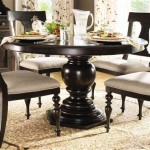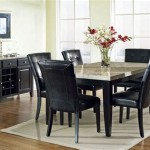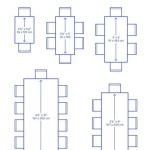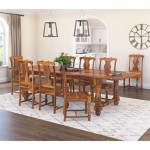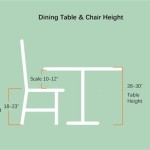Reclaimed Wood Extendable Dining Tables: Sustainability, Style, and Functionality
Reclaimed wood extendable dining tables represent a confluence of several desirable qualities in furniture design. They offer a sustainable alternative to newly manufactured wood products, provide a unique aesthetic appeal rooted in history, and offer practical functionality through their extendable design. These tables are increasingly popular among homeowners seeking to furnish their dining spaces with pieces that are both environmentally responsible and adaptable to varying needs.
The concept of reclaiming wood involves salvaging timber from older structures, such as barns, factories, and even sunken logs, and repurposing it for new applications. This process diverts wood from landfills, reduces the demand for virgin timber, and preserves the character and history embedded within the wood itself. Extendable dining tables, in turn, offer flexibility in accommodating different numbers of diners, making them ideal for both everyday use and special occasions.
The combination of these two elements – reclaimed wood and extendable design – creates a piece of furniture that is not only visually appealing and environmentally conscious but also highly functional and adaptable. This article will delve into the various aspects of reclaimed wood extendable dining tables, exploring their benefits, considerations for choosing the right table, and maintenance requirements.
Environmental Benefits of Reclaimed Wood
The utilization of reclaimed wood in furniture production offers significant environmental advantages. The most obvious benefit is the reduction in deforestation. By repurposing existing timber, the demand for newly harvested trees is lessened, contributing to the preservation of forests and their ecosystems. Forests play a crucial role in carbon sequestration, absorbing carbon dioxide from the atmosphere and mitigating climate change. Reducing deforestation helps to maintain this vital function.
Furthermore, the process of manufacturing new wood products requires considerable energy input, from logging and transportation to milling and processing. Reclaimed wood, on the other hand, requires significantly less energy to prepare for reuse. The wood has already been processed and seasoned, reducing the need for energy-intensive kiln drying. The primary energy expenditure in reclaiming wood is associated with cleaning, trimming, and refinishing the material, which is generally less than the energy required for processing new timber.
Another environmental benefit is the reduction of waste. Construction and demolition waste is a significant contributor to landfills. By reclaiming wood from these sources, the volume of waste sent to landfills is reduced, conserving valuable landfill space and mitigating the environmental impacts associated with landfill decomposition, such as methane gas emissions.
In many cases, reclaimed wood possesses characteristics that are superior to those of newly harvested wood. Older trees often grew more slowly, resulting in denser, stronger wood. This density makes reclaimed wood more resistant to warping and cracking, contributing to the longevity of the furniture made from it. Additionally, reclaimed wood often exhibits unique grain patterns and textures that are not found in new wood, adding to its aesthetic appeal.
Aesthetic Considerations and Style Variations
Reclaimed wood dining tables offer a wide range of aesthetic possibilities, each reflecting the history and character of the wood from which they are made. The type of wood, its age, and its previous use all contribute to the unique appearance of each table. For example, barn wood often displays a rustic, weathered look, with nail holes, saw marks, and variations in color that tell a story of its past. Factory floor wood may exhibit a more industrial aesthetic, with signs of wear and tear from years of use.
The finish applied to the reclaimed wood can further enhance its aesthetic appeal. A natural oil finish can highlight the wood's natural grain and texture, while a painted finish can provide a more contemporary look. The choice of finish will depend on the overall style of the dining room and the desired aesthetic. Some prefer a minimalist approach, allowing the wood's natural beauty to shine through with a simple clear coat, while others opt for a more dramatic look with a stained or painted finish.
The design of the table base also plays a crucial role in the overall aesthetic. Options range from simple, clean lines to more elaborate, decorative designs. Metal legs, often made from reclaimed steel, can provide an industrial-chic look, while wooden legs can complement the wood of the tabletop. The shape of the legs, whether straight, tapered, or curved, can also contribute to the overall style of the table.
The extendable mechanism itself can also be a design element. Some tables feature hidden extensions that slide out seamlessly, while others have extensions that are stored separately and added manually. The type of extension mechanism will depend on the table's design and the desired level of convenience. Butterfly leaf extensions, self-storing leaves, and drop-leaf extensions are common types, each offering a different approach to extending the table's surface area. The integration of the extension mechanism should be considered carefully to ensure it complements the overall design of the table and does not detract from its aesthetic appeal.
Beyond the wood and finish, the overall style of the table can be further customized through the selection of chairs and other dining room accessories. A reclaimed wood table can be paired with a variety of chair styles, from modern and minimalist to traditional and ornate. The choice of chairs will depend on the desired overall aesthetic and the comfort of the diners. Similarly, the choice of lighting, rugs, and other accessories can further enhance the style of the dining room and complement the reclaimed wood table.
Practical Considerations for Choosing and Maintaining a Reclaimed Wood Extendable Dining Table
When selecting a reclaimed wood extendable dining table, several practical considerations should be taken into account. The size of the table is a crucial factor, as it needs to fit comfortably within the dining space while also providing adequate seating for the desired number of diners. The extension mechanism should be easy to operate and the extension leaves should be stored conveniently when not in use. The table's weight and stability should also be considered, especially if it will be moved frequently.
The type of wood used in the table's construction is another important consideration. Different types of wood have different properties, such as hardness, durability, and resistance to moisture. Some reclaimed wood species are more susceptible to damage than others, so it is important to choose a wood that is appropriate for the intended use and environment. The age and condition of the reclaimed wood should also be carefully assessed to ensure that it is structurally sound and free from pests or decay.
Maintenance is essential for preserving the beauty and longevity of a reclaimed wood dining table. Regular cleaning with a soft cloth and mild soap is generally sufficient to remove dirt and spills. Harsh chemicals and abrasive cleaners should be avoided, as they can damage the finish and the wood itself. Periodic waxing or oiling can help to protect the wood and enhance its natural beauty. The frequency of waxing or oiling will depend on the type of finish applied to the table and the level of use it receives.
Care should be taken to protect the table from excessive moisture and heat. Spills should be cleaned up promptly to prevent staining or water damage. Hot dishes and cookware should be placed on trivets or placemats to prevent heat damage. Humidity levels should be kept within a relatively stable range to prevent warping or cracking of the wood. In dry climates, a humidifier may be necessary to maintain adequate moisture levels. In humid climates, a dehumidifier may be necessary to prevent excessive moisture buildup.
Scratches and minor damage can be repaired with furniture touch-up markers or repair kits. More significant damage may require professional repair. It is important to address any damage promptly to prevent it from worsening. Regular inspections of the table's structure and finish can help to identify potential problems early on, allowing for timely repairs and preventative maintenance.
The extendable mechanism should also be maintained properly to ensure its smooth operation. The mechanism should be cleaned and lubricated periodically to prevent sticking or binding. The extension leaves should be stored in a dry, protected location to prevent warping or damage. The table should be extended and retracted periodically to ensure that the mechanism remains in good working order.
By carefully considering these practical factors and following proper maintenance procedures, a reclaimed wood extendable dining table can provide years of enjoyment and become a cherished centerpiece in the dining room.

Extendable Dining Table Reclaimed Wood The Mitre Etsy

Breadboard Farmhouse Extendable Dining Table

North Reclaimed Wood Extending Dining Table Pottery Barn

Farmhouse Extendable Dining Table

Emmerson 72 93 Expandable Rectangle Dining Table Natural Rustic West Elm

Reclaimed Extending Dining Table With Black Box Steel Legs Customisable Size Finish Etsy

Hart Round Reclaimed Wood Pedestal Extending Dining Table Black Olive 63 79 L Pottery Barn

Liberty Extendable Dining Table With A Reclaimed Barnwood Option

Lyle Lodge Extendable Reclaimed Pine Dining Table 72 96 W

42 X60 None Natural

